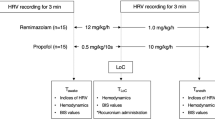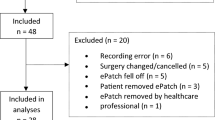Abstract
The purpose of this study was to use estimates of corrected QT dispersion (QTcd) and heart rate variability (HRV) to assess the effects of sevoflurane, an inhalation agent used frequently in clinical practice, on autonomic cardiac function. This study was conducted prospectively and in a blind manner on 20 women between 38 and 51 y of age who were classified as American Society of Anesthesiologists stage I–II and whose treatment required total abdominal hysterectomy. Electrocardiograms were recorded by 12-lead Holter monitor for 5 min before sevoflurane induction and again for 5 min at 10 min after tracheal intubation. Data on the first recording were considered as baseline; those on the second recording were viewed as final data. The study was terminated at this point, and surgery was allowed to proceed. QTcd and HRV values were assessed by a cardiologist, who was blinded to all data. All parameters were expressed as a mean value ± standard deviation. Wilcoxon’s test was used to compare baseline and final data. Statistical significance was considered asP< .05. No significant changes were observed between baseline and final QTcd values and between low and high-frequency components (LF and HF) of HRV; nor were changes seen in the LF/HF ratio. With the patient under sevoflurane/nitrous oxide anesthesia, no significant changes were detected in QTcd, LF, and HF values, and in the LF/HF ratio, whereas a significant increase (P=.001) was seen in standard deviation of the R-R interval, which was used as a measure of cardiac autonomic tone.
Similar content being viewed by others
References
Yildirim H, Adanir T, Katircioglu K, Savaci S. The effects of sevoflurane, isoflurane and desflurane on QT interval of the EKG.Eur J Anaesthesiol. 2004;21:566–570.
Sen S, Ozmert G, Boran N, Turan H, Caliskan E. Comparison of single-breath vital capacity rapid inhalation with sevoflurane 5% and propofol induction on QT interval and haemodynamics for laparoscopic surgery.Eur J Anaesthesiol. 2004;21:543–546.
Batchvarov V, Malik M. Measurement and interpretation of QT dispersion.Prog Cardiovasc Dis. 2000;42:325–344.
Perkiomaki JS, Huikuri HV, Koistinen FJM, Makikallio T, Castellanos A, Myerburg RJ. Heart rate variability and dispersion of QT interval in patients with vulnerability to ventricular tachycardia and ventricular fibrillation after previous myocardial infarction.J Am Coll Cardiol. 1997;30:1331–1338.
Day CP, McComb JM, Campbell RWF. QT dispersion: an indication of arrhythmia risk in patients with long QT intervals.Br Heart J. 1990;63:342–344.
Kuenszberg E, Loekinger A, Kleinsasser A, Lindner KH, Puehringer F, Hoermann C. Sevoflurane progressively prolongs the QT interval in unpremedicated female adults.Eur J Anaesthesiol. 2001;17:662–664.
Lehmann MH, Hardy S, Archibald D, et al. QTc prolongation with d,l-sotalol in women versus men.Am J Cardiol. 1999;83:354–359.
Perkiomaki J, Koistinen MJ, Yli-Mayry S, Huikuri HV. Dispersion of QT interval in patients with and without susceptibility to ventricular tachyarrhythmias after previous myocardial infarction.J Am Cardiol. 1995;26:174–179.
Huikuri HV, Koistinen MJ, Yli-Mayry S, Airaksinen KEJ, Myburg RJ. Impaired low frequency oscillation of heart rate in patients with prior acute myocardial infarction and life-threatening arrhythmias.Am J Cardiol. 1995;76:56–60.
Farrel TG, Bashir Y, Cripps T, et al. Risk stratification for arrhythmic events in postinfarction patients based on heart rate variability, ambulatory electrocardiographic variables and the signal averaged electrocardiogram.J Am Coll Cardiol. 1991;18:687–697.
Bigger JT, Fleiss JL, Steiman RC, Rolnitzky LM, Kleiger RE, Rottman JN. Frequency domain measures of heart rate period variability and mortality after myocardial infarction.Circulation. 1992;85:164–172.
Task Force of the European Society of Cardiology and the North American Society of Pacing and Electrophysiology. Heart rate variability: standards of measurement, physiological interpretation and clinical use.Circulation. 1996;93:1043–1065.
Stein PK, Bosner MS, Kleiger RE, Conger BM. Heart rate variability: a measure of cardiac autonomic tone.Am Heart J. 1994;127:1376–1381.
Kleiger RE, Miller JP, Bigger JT Jr, Moss AJ. Decreased heart rate variability and its association with increased mortality after acute myocardial infarction.Am J Cardiol. 1987;59:256–262.
Kleiger RE, Miller JP, Krone RJ, Bigger JT Jr. The independence of cycle length variability and exercise testing in predicting mortality of patients surviving acute myocardial infarction. The Multicenter Postinfarction Research Group.Am J Cardiol. 1990;65:408–411.
Guler N, Bilge M, Eryonucu B, Kati I, Demirel CB. The effects of halothane and sevoflurane on QT dispersion.Acta Cardiol. 1999;54:311–315.
Gurkan Y, Canatay H, Agacdiken A, Ural E, Toker K. Effects of halothane and sevoflurane on QT dispersion in paediatric patients.Paediatr Anaesth. 2003;13:223–227.
Kleinsasser A, Kuenszberg E, Loeckinger A, et al. Sevoflurane, but not propofol, significantly prolongs the Q-T interval.Anesth Analg. 2000;90:25–27.
Kleinsasser A, Loeckinger A, Lindner KH, Keller C, Boehler M, Puehringer F. Reversing sevoflurane-associated Q-Tc prolongation by changing to propofol.Anaesthesia. 2001;56: 248–250.
Abe K, Takada K, Yoshiya I. Intraoperative torsade de pointes ventricular tachycardia and ventricular fibrillation during sevoflurane anaesthesia.Anesth Analg. 1998;86:701–702.
Chauhan VS, Krahn AD, Walker BD, et al. Sex differences in QTc interval and QT dispersion: dynamics during exercise and recovery in healthy subjects.Am Heart J. 2002;144:858–864.
Ebert SN, Liu XK, Woosley RL. Female gender as a risk factor for drug-induced cardiac arrhythmias: evaluation of clinical and experimental evidence.J Womens Health. 1998;7:547–557.
Rich MV, Saini JS, Kleiger RE, Carney RM, Velde A, Freedland KE. Correlation of heart rate variability with clinical and angiographic variables and late mortality after coronary angiography.Am J Cardiol. 1988;62:714–717.
Nakatsuka I, Ochiai R, Takeda J. Changes in heart rate variability in sevoflurane and nitrous oxide anaesthesia: effects of respiration and depth of anaesthesia.J Clin Anesth. 2002;14:196–200.
Kanaya N, Satoh H, Seki S, Nakayama M, Namiki A. Propofol anesthesia enhances the pressor response to intravenous ephedrine.Anesth Analg. 2002;94:1207–1211.
Kanaya N, Hirata N, Kurosawa S, Nakayama M, Namiki A. Differential effects of propofol and sevoflurane on heart rate variability.Anaesthesiology. 2003;98:34–40.
Author information
Authors and Affiliations
Rights and permissions
About this article
Cite this article
Ugur, B., Sen, S., Tekten, T. et al. Effects of sevoflurane on QT dispersion and heart rate variability. Adv Therapy 23, 439–445 (2006). https://doi.org/10.1007/BF02850165
Issue Date:
DOI: https://doi.org/10.1007/BF02850165




